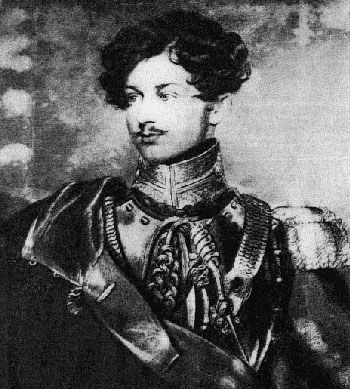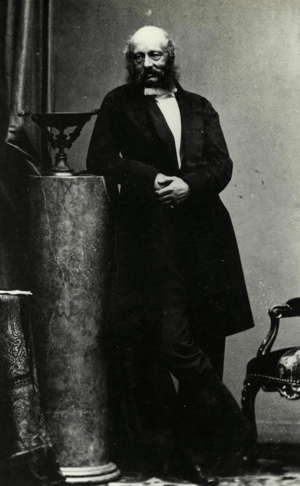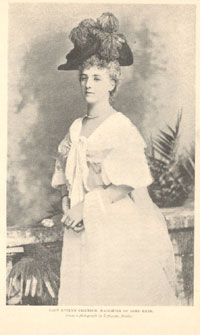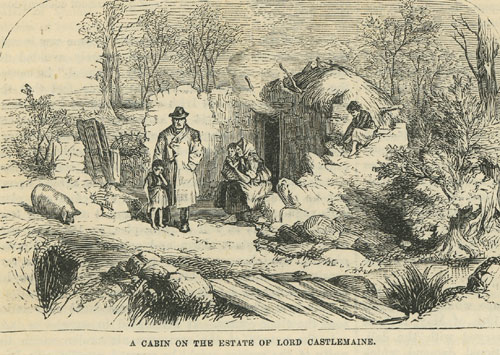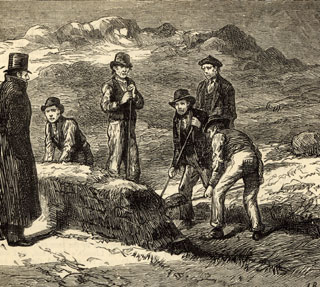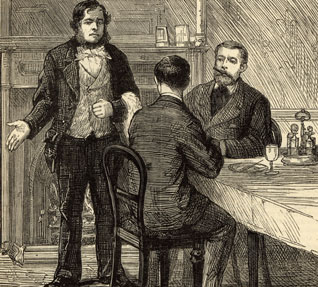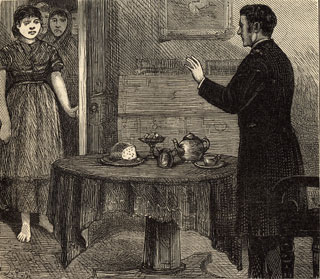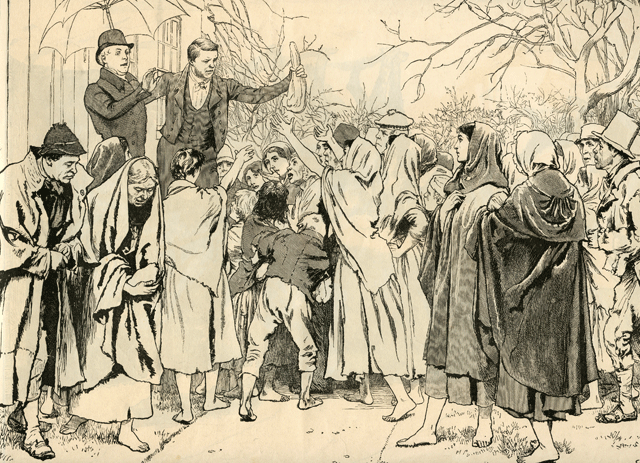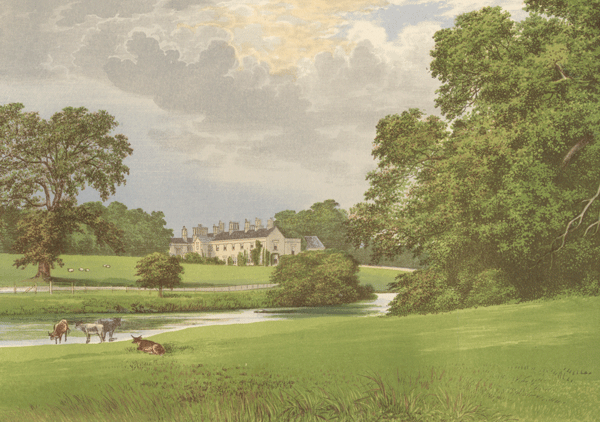|
The Nolans, Early Landlords
In October 2005 Nolan family descendant, Glenn Nolen, emailed the following information on the Nolan
family in Ballinrobe:
My Nolan family purchased Creagh Castle in 1582 and apparently were
the owners of Creagh Castle and the Castle at Ballinrobe until 1653 when confiscated by
the Cromwellian Government.
The below information is from my site 1,000 Years of O'Nolan History:
Nolan Ancestry
"Before proceeding further it is necessary to explain the apparent absence of
Creagh from the List of Castles of 1574. It and Coslough were divided from one another by the
river Robe and both, it is believed, were MacTibbot Bourke manors as we will now
endeavour to show.
The Norman ruler who set up in Ballinrobe about 1236-7 would not have been content,
in peaceful times, without a country residence. Creagh was an ideal position, in that a castle
in the demesne would be only a mile from Ballinrobe and yet within a short distance from
Lough Mask. The triangle of which the mouth of the Robe to Keel bridge is the base,
and Ballinrobe the apex, was occupied by the O'Gormly tribe in pre-Norman times and they
appear to have been transplanted about 1236. We may reasonably contend therefore that the
Creagh site was available and selected for what we might call a suburban residence of the
ruler of Kilmaine in the Norman period.
G. V. Martyn continues with the next entry in the 1574 List of Castles to which
we must draw attention is that Walter MacTibbot had Crigh. Knox argues that Crigh is
Creevagh in the parish of Kilmolara. To show that this is in error we must quote the following
evidence:
(i). Knox (a) p. 205-MacTibbot's Castle of the Crigh.
(b) p. 284-MacTibbot's Castle of the Crich or Criche.
(ii). Composition-THOMAS NOLAN got Creevagh.
(iii). Strafford's Survey-THOMAS NOLAN at Cryah.
(iv). Hardiman's Note, p. 251 in Iar-Connacht.-Creevagh is Creagh
and was forfeited by the NOLAN'S in Cromwell's time and acquired by
James Cuff.
"It would thus appear that in 1574 Walter MacTibbot's Castle of Crigh* was that of
Creagh. He sold it to THOMAS NOLAN in 1582."
This quote is from the Journal of the Galway Archaeological
and Historical Society, JGAHS, Vol. XIII. (1925), Nos. I and II. Random Notes on the History of
County Mayo by G. V. Martyn, 83-100.
2 July 1607 - THOMAS NOLAN, described as "of Ballinrobe" got a
grant by patent from King James I "of the 4 quarters of Ballinrobe."
After obtaining the patent grants of Ballinrobe, if not earlier,
THOMAS NOLAN went into occupation of the new castle at Ballinrobe,
for the old castle attached to the Mac William's had probably even
then become ruinous: every vestige of it has long since
disappeared. Mr. Hubert Knox considers that its site was on the
east bank of the river Robe, about where the iron bridge now is,
but on the high ground.
20 August 1617 - THOMAS NOLAN of Ballinrobe re-granted by patent
the castle and manor of Ballinrobe, with 4 quarters.
18 June 1628 - THOMAS NOLAN of Ballinrobe died. GREGORY NOLAN,
the eldest son of THOMAS NOLAN, continued this family's succession
at Ballinrobe Castle.
1653 - "GREGORY NOLAN'S estate was confiscated by the Cromwellian
Government."
Glenn Allen Nolen
On his web page
Nolan Ancestry Glenn Nolen adds
THOMAS NOLAN of Ballinrobe died in 1628 and was succeeded at Ballinrobe by his
eldest son GREGORY NOLAN. GREGORY NOLAN'S estate was confiscated by the Cromwellian
Government in 1653, and was granted in 1655 by the Cromwellian Commissioners to James Cuff,
who was one of those Commissioners. This James Cuff was Knighted on 12th March 1661 and
was confirmed in the possession of the Manor and Castle of Ballinrobe as well as
extensive estates in the Barony of Tyrawley, by a patent under the Acts of Settlement,
enrolled on the 2nd March 1666. The above quote is from
Notes on Ballinrobe, Co.
Mayo and the Families of Burke, NOLAN, Cuff, and Knox written by Martin J. Blake, 1909.
The Brownes,
the Neale - Early Landlords
From Landed Estates
"(Estate) Browne/Dillon-Browne (Glencorrib) - A branch of the Browne family of the Neale,
barony of Kilmaine, county Mayo, settled near the village of Kilmaine and were generally
known as of 'Ellistron' in the 18th century. In 1681 Valentine Browne was granted over
2,000 acres in the baronies of Kilmaine, Carra, Gallen and Tirawley, county Mayo with
lands in counties Galway and Clare. In the 18th century the main part of the
estate was in the parishes of Kilmainemore and Shrule. Two of the townlands
belonging to them in the parish of Shrule, Mocorha and Bunnafollistran, had been
sold to Sir Walter Blake in September 1699 by the trustees for the sale of the estate of
Colonel John Browne of Westport. Robert Browne of Ellistron, parish of Kilmainemore,
had a son Arthur who lived at Turin in the early 19th century. By the time of the first
Ordnance Survey the Brownes were living at Glencorrib in the parish of Shrule.
The last member of the family to reside at Glencorrib was Robert Dillon Browne,
Member of Parliament and well known duellist, who sold the Browne estate
in the barony of Kilmaine and the Holywell estate in the barony of Costello,
county Mayo, in the early 1850s. The Glencorrib estate was bought by the
Higgins family of Westport and James D. Meldon and the Kilmaine lands by Robert
Tighe and Robert Fair. In 1882 over 150 acres in the baron of Longford, county
Galway, the property of Arthur and Anne Dillon-Browne was offered for sale in the
Land Judges court. In July 1882 the Irish Times reported that the Court had
been informed that the tenants on the estate were willing to offer a total
of £1106 to buy the property but that the owner sought a bid of up to £3000.
The sale was adjourned."
The Browne family had a great house at Glencorrib. Their estate included the villages of
Mochara, Cahir, Bunnafollistran and Ravenhill.
The House of Commons, as Elected to the Fourteenth Parliament of the United:
"Browne, Robert-Dillon: son of the late Arthur Browne, Esq., of Glencorrib, co. Mayo;
first returned for the county on the Rt. Hon. Dominick Browne being created Baron Oranmore,
May 1836, when he was proposed by Dr. M'Hale, Catholic Archbishop of Tuam; a Repealer;
descends from the Kilmaine family; is cousin to the Countess of Ripon, and nephew of
Thomas Martin, Esq., M.P. for Galway co."
Robert Dillon Browne son of Arthur Browne and Mary Kirwan died in 1850
The Gentleman's Magazine, Volume 34
"July 1. In London, in his 39th year, Robert Dillon Browne, esq. M.P. for the county of Mayo.
He was the son of Arthur Browne, esq. of Glencorrib, co. Mayo; and was first elected to
Parliament for that county in the year 1836, in the place of the Right Hon. Dominick Browne,
then created Lord Oranmore and Browne. He was invariably found among the most liberal
supporters of the Whig government. Mr. Browne was in the enjoyment of his usually
excellent health until Friday the 28th June, when premonitory symptoms of gout
developed themselves. On that evening, contrary to the advice of his medical advisers,
he attended in bis place in the House of Commons for the purpose of recording his
vote in favour of Lord Palmerston's foreign policy, and there is little doubt
that the excitement and exposure to cold necessarily consequent on that step,
tended to aggravate the illness with which he was threatened. On the following
day he was seized with a violent attack of gout in the head, which terminated fatally.
For some time previous to his death he was busily engaged in asserting his claims
to the dormant Irish peerage of Roscommon.
Mr. Browne was an accomplished classical scholar, and a very able speaker.
As a popular orator he had few superiors, and, though he spoke but seldom in the House of
Commons, he never failed to command attention and respect."
The house at Glencorrib passed to George Gore Ouseley Higgins M. P. of Glencorrib and Mount Pleasant. He
was born 15 October 1818 and was High Sheriff of Mayo in 1868.
The house at Glenncorrib is not longer standing.
In August 2016 Laurence Gilmore sent me a copy of a document dated 1719 that listed
a deed for Josias Browne of "Ellistron" County Mayo (noting earlier deed of 1707). There are two townlands in Kilmaine that
related to the name: Ellistronparks at about 76 acres and Ellistronsbeg at about 344 acres. The properties are
contiguous and are situated north east of the village of Kilmaine towards the town of Ballinrobe. They were in the Poor Law Union of Ballinrobe.
The Browne family of the Neale settled in Kilmaine parish and had a "castle" at "Ellistron".
In the 1700s they also owned two townlands in Shrule parish:
Mocorha and Bunnafollistran. Later the family lived in Glencorrib at Shrule Parish.
Robert Dillon Browne a member of parliament was the last family member to live at Glenncorrib.
The property was sold at his death in the early 1850s. Robert Tighe and Robert Fair bought the property in
Kilmaine.
Josias Browne of Ellistron, Kilmaine, was the son of Valentine Browne. Josias
had a will dated 11 March 1726 according to Digital Irish Genealogy and the Moore Institute.
Children of Josias Browne:
-
Mary Browne daughter of Josias Browne of Ellistown, Co Mayo married Mark Blake, Ballinfad. Mark Blake died in 1755.
Mary Browne Blake died in 1760. They had two sons and three daughters.
(Blake Family Records)
- Valentine of Ellistron eldest son of Josias Browne
- Robert - 3rd son of Josias Browne
Child:
Arthur Browne - son of Robert - married Mary Kirwan
lived at Turin Castle in 1814 - died 1841
Child:
-
ROBERT DILLON BROWNE, MP - died bankrupt in 1850 -
only son of Arthur Browne - Turin Castle & Glencorrib, and Mary Kirwan.
Robert Dillon Browne was a Member of Parliament for Co Mayo (1836-1850).
Married Anne Blake, daughter of Dr. Henry Blake of Glenloe, near Galway,
They had three sons : Arthur, Thomas and Robert.
Brown, Vall., of Ellistrin. D. Tuam. Dec. 24th 1726. Converts from Popery to Protestant Religion in Ireland, from the Commencement of the Reign of Queen Anne to 1772.
1836: Tithe Applotment listed Fair, Robert, as the tenant at:
-
Ellistronbeg Kilmainemore, 272 1st quality acres, and 50 acres of 2nd quality pasture
- Ellistron Browne, 46 acres 1st quality
- Thomastove 33 acres 1st quality and 27 acres of pasture
- Gatepark, Arthur Browne Esq., 40 acres 1st quality
1805: The post-chaise companion: or, Travellers directory through Ireland. To ...
By William Wilson (topographer.)
"Four miles below Ballinrobe, pn the R. is Cornfield, the seat of Mr. Gildea; and on the L. Browne's-town, that of Mr. Browne.
Two miles and a quarter beyond Ballinrobe on the R. are the ruins of a church: and a mile farther,
on the L. is Ellistron, the seat of Mr. Browne.
Near Kilmain, on the L. are the ruins of a church; and half
main, on the L. is Turin - castle, the pleasant seat of Mr. Browne.
Within a mile and a half of Shrule, on the R. are the ruins of an abbey; and about
half a mile, on the R. those of a castle; both situated at the side of a lake."
1838: Robert Dillon Brown M. P. and Mr. James Browne of Brown Hall in Mayo fought a duel near Chester.
Robert Dillon Browne was wounded in the thigh.
The quarrel arose over the elections in Mayo.
1840:
"FIGHTING INTELLIGENCE
On Wednesday Robert Dillon Browne, Esq., M.P. for Mayo, arrived in this town. The honourable gentleman stopped at Daly's hotel to change horses, and on entering the coffee-room met Charles Blake, Esq., senior, whom he accosted, and offered to shake hands with, but which Blake disdainfully refused. Shortly after they again met in the streets, and Mr. Brown coming close to Mr. Blake, enquired why he refused his hand?-Neither Mr. Blake's reply nor Mr. Browne's retort were heard by the nearest by standers; but Mr. Blake was observed to rise his hand, in which he held a stick, as if with an intent to strike Mr. Browne, who either in the effort to ward off the blow, or with design, bled his nose. The circumstances having been reported to the Magistrates presiding at the Petty Sessions, they adjourned the court, and accompanied by the police, came down to town.- Tomkins Brew, Esq., put both parties under arrest. His Grace the Archbishop, the Very Rev. Doctor Kirwan and several gentlemen endeavoured to procure an explanation but without effect. Mr. Brown was found to keep the peace; but Mr. Blake refused to enter securities, alledging he was not the aggressor, and Mr. Brew took him away in custody. Shortly after Mr. Browne left for Ballinasloe, amidst the cheering of the persons whom the circumstance had collected about the hotel. We understand Mr. Browne expressed his willingness to make any apology, if Mr. Blake would, on his honour, declare he did not intend to strike him before he (Mr. Browne)
raised his hand. -- Tuam Herald."
1843: The Asiatic Journal and Monthly Miscellany
"The consequences which the lower classes of the Irish, and some of the upper, evidently expect from this new state of things, may be collected from what occasionally transpires at the repeal meetings. At that of Clifden, Mr. R. Dillon Browne, M.P., " ex-deputy lieutenant, and ex-justice of the peace," incautiously demonstrated the propriety of his removal from these posts, by threatening a highly respectable gentleman, Mr. D'Arcy, whom Mr. Browne characterized as a " contemptible wretch," with being soon visited by " fixity of tenure," a principle which, he added, "repeal would soon establish." Mr. O'Connell has endeavoured to expound what he terms "equity of tenure," in a comparatively innocent sense, namely, that every man who expends money upon the improvement of his farm should receive the amount he had expended upon it, on quitting the farm; but it is evident that Mr. Browne, M.P., and no doubt many who are not M.P.'s, give a much more enlarged and liberal construction to the phrase, "fixity of tenure."
1844:
Hand-book for Ireland
By James Fraser:
"In branching off No. 119 at Roundfort, we leave the village of Kilmaine
and Ellistrin Castle, Browne,
Esq., between three and four miles to the south of our road, and skirt the pastoral
tract of lands called the Plains of Ellistrin."
1847:
The Dublin almanac, and general register of Ireland, for 1847 - Robert Dillon Browne, esq. Reform Club,
London; and Ellistron and Glencorrib, in this county.
1850 July
"It is with much regret we have to announce the sudden demise Mr. Robert Dillon Browne, M.P. for the Co. of Mayo."
1850: The Irish Jurist Vol 2 - 3,200 acres of Land for sale in 7 lots from
estate of Robert Dillon Browne, esq deceased, in the name of his eldest son, Arthur Dillon Browne a minor.
The Irish Jurist
Lot 3
Mocarha containing 603 acres, 11 perches, Stature Measure, untenanted....
1851: The Irish Jurist Vol 3 - In the matter of the estate of Robert
Dillon Browne in the name of his eldest son, Arthur Dillin Browne, a minor, notice of the sales of
various estates
in the Barony of Costell and the County of Mayo which included
"the Kilmaine Estate" which encompassed "the Lands of Bunnafillistron", "the Lands of Mocharha",
Ellistron Park, Ellistron and several others in the court of the Commissioner For the Sale of Incumbered
Estates in Ireland.
Arthur Dillon Brown, the son of Robert Dillon Browne sold the estates following the death of his father.
"Robert Dillon Browne was a bankrupt Mayo MP addicted to sherry,
who sometimes had to borrow a suit before appearing in parliament". (John Blake Dillon: Young Irelander)
1878: The Crusade of the Period: and Last Conquest of Ireland
By William Dillon "there had long been an anxious wish amongst decent people to get rid of Dillon Browne, member for Mayo,
a great Repealer, but a bloated bon vivant and an insolvent debtor"
Dillon-Browne of Glencorrib
My ancestor lived in Mochara: Nappy Naughton born circa 1813 married Michael Bryne born circa 1789.
They had: Peter c 1831, Margaret c 1833, Nappy c 1835,
Winny c 1838, Thomas c 1840. Nappy born c 1835 married Matthias Langan. They were the
parents of Margaret (Maggie) born in Mochara in 1875. She is my great grandmother.
Brynes still live in Mochara.
See Brynes of Mochara
|


